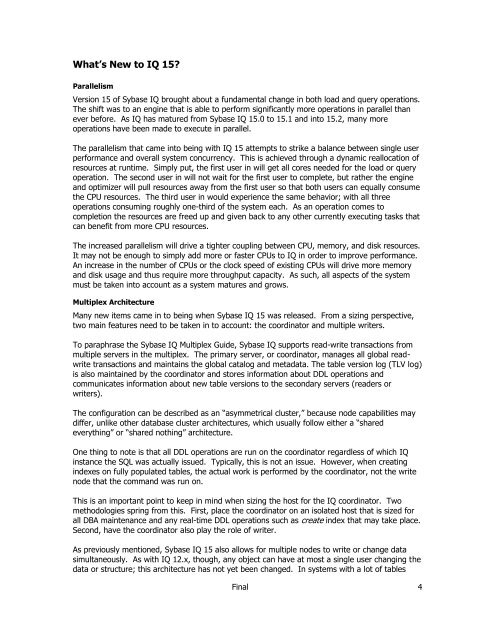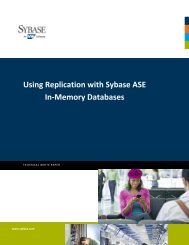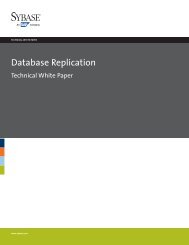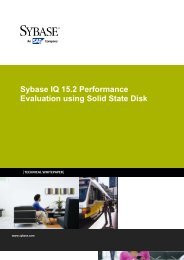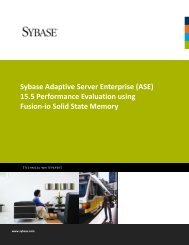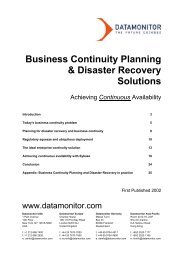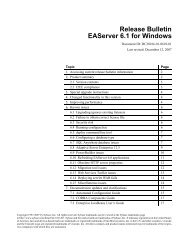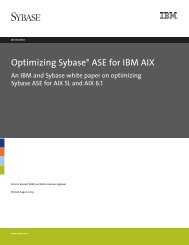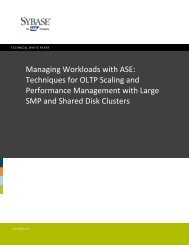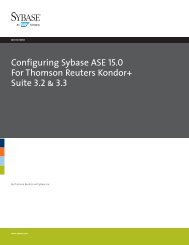A Practical Hardware Sizing Guide for Sybase IQ
A Practical Hardware Sizing Guide for Sybase IQ
A Practical Hardware Sizing Guide for Sybase IQ
You also want an ePaper? Increase the reach of your titles
YUMPU automatically turns print PDFs into web optimized ePapers that Google loves.
What’s New to <strong>IQ</strong> 15?<br />
Parallelism<br />
Version 15 of <strong>Sybase</strong> <strong>IQ</strong> brought about a fundamental change in both load and query operations.<br />
The shift was to an engine that is able to per<strong>for</strong>m significantly more operations in parallel than<br />
ever be<strong>for</strong>e. As <strong>IQ</strong> has matured from <strong>Sybase</strong> <strong>IQ</strong> 15.0 to 15.1 and into 15.2, many more<br />
operations have been made to execute in parallel.<br />
The parallelism that came into being with <strong>IQ</strong> 15 attempts to strike a balance between single user<br />
per<strong>for</strong>mance and overall system concurrency. This is achieved through a dynamic reallocation of<br />
resources at runtime. Simply put, the first user in will get all cores needed <strong>for</strong> the load or query<br />
operation. The second user in will not wait <strong>for</strong> the first user to complete, but rather the engine<br />
and optimizer will pull resources away from the first user so that both users can equally consume<br />
the CPU resources. The third user in would experience the same behavior; with all three<br />
operations consuming roughly one-third of the system each. As an operation comes to<br />
completion the resources are freed up and given back to any other currently executing tasks that<br />
can benefit from more CPU resources.<br />
The increased parallelism will drive a tighter coupling between CPU, memory, and disk resources.<br />
It may not be enough to simply add more or faster CPUs to <strong>IQ</strong> in order to improve per<strong>for</strong>mance.<br />
An increase in the number of CPUs or the clock speed of existing CPUs will drive more memory<br />
and disk usage and thus require more throughput capacity. As such, all aspects of the system<br />
must be taken into account as a system matures and grows.<br />
Multiplex Architecture<br />
Many new items came in to being when <strong>Sybase</strong> <strong>IQ</strong> 15 was released. From a sizing perspective,<br />
two main features need to be taken in to account: the coordinator and multiple writers.<br />
To paraphrase the <strong>Sybase</strong> <strong>IQ</strong> Multiplex <strong>Guide</strong>, <strong>Sybase</strong> <strong>IQ</strong> supports read-write transactions from<br />
multiple servers in the multiplex. The primary server, or coordinator, manages all global readwrite<br />
transactions and maintains the global catalog and metadata. The table version log (TLV log)<br />
is also maintained by the coordinator and stores in<strong>for</strong>mation about DDL operations and<br />
communicates in<strong>for</strong>mation about new table versions to the secondary servers (readers or<br />
writers).<br />
The configuration can be described as an “asymmetrical cluster,” because node capabilities may<br />
differ, unlike other database cluster architectures, which usually follow either a “shared<br />
everything” or “shared nothing” architecture.<br />
One thing to note is that all DDL operations are run on the coordinator regardless of which <strong>IQ</strong><br />
instance the SQL was actually issued. Typically, this is not an issue. However, when creating<br />
indexes on fully populated tables, the actual work is per<strong>for</strong>med by the coordinator, not the write<br />
node that the command was run on.<br />
This is an important point to keep in mind when sizing the host <strong>for</strong> the <strong>IQ</strong> coordinator. Two<br />
methodologies spring from this. First, place the coordinator on an isolated host that is sized <strong>for</strong><br />
all DBA maintenance and any real-time DDL operations such as create index that may take place.<br />
Second, have the coordinator also play the role of writer.<br />
As previously mentioned, <strong>Sybase</strong> <strong>IQ</strong> 15 also allows <strong>for</strong> multiple nodes to write or change data<br />
simultaneously. As with <strong>IQ</strong> 12.x, though, any object can have at most a single user changing the<br />
data or structure; this architecture has not yet been changed. In systems with a lot of tables<br />
Final<br />
4


